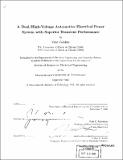A dual/high-voltage automotive electrical power system with superior transient performance
Author(s)
Caliskan, Vahe
DownloadFull printable version (18.09Mb)
Other Contributors
Massachusetts Institute of Technology. Dept. of Electrical Engineering and Computer Science.
Advisor
John G. Kassakian.
Terms of use
Metadata
Show full item recordAbstract
Today's automotive electrical power system is based on an engine-driven alternator regulated at 14 V which charges a 12 V battery and delivers power to the loads. Installed electrical power is growing rapidly with model year, and future electrical power requirements are expected to exceed the capability of the present 14 V system by about 2005. A high/dual-voltage electrical system is necessary to meet these requirements. A new alternator system which substantially improves the present Lundell alternator design is proposed. This new system can double the output power and greatly improve efficiency without the need to rewind the machine. Inherent load-dump transient suppression and jump-start charging features are also achieved. The attributes of this novel system have been experimentally demonstrated. The main goal of this thesis is to investigate and develop analytical system and subsystem models for dual/high-voltage automotive electrical systems. Detailed time-domain and simplified averaged models for synchronous machines and three-phase rectifiers with constant-voltage loads are developed. A load-matching technique based on a switched-mode rectifier is introduced and used in conjunction with the developed machine/rectifier models to design the new high-power, highefficiency alternator system. Analytical models for two dual-voltage systems, one based on interleaved dc/dc converters and the other on a dual-stator Lundell alternator, are developed and used to investigate their characteristics. The analytical models for the dc/dc converter system are used in the design of a prototype which experimentally demonstrates the high performance features of the system while verifying the analytical results. A comparison of the characteristics of dual/high-voltage architectures is presented and it is shown that the load-matching technique can be used in a number of dual-voltage systems to improve performance. An attractive complete dual-voltage system, which incorporates the new alternator and a dc/de converter, is introduced.
Description
Thesis (Sc.D.)--Massachusetts Institute of Technology, Dept. of Electrical Engineering and Computer Science, 2000. Includes bibliographical references (p. 235-239).
Date issued
2000Department
Massachusetts Institute of Technology. Department of Electrical Engineering and Computer SciencePublisher
Massachusetts Institute of Technology
Keywords
Electrical Engineering and Computer Science.